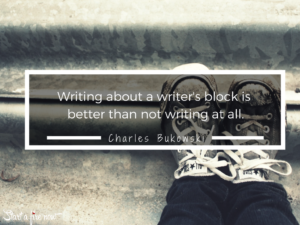 In my previous post, I talked about how important it is to be a good writer and why it can affect your performance and chances of promotion on the job. I shared a link to a blocking questionnaire to help you learn which of the top seven writing problems affects you the most. If you haven’t taken the quiz yet, you can access it by clicking here. Head back over to my previous post and arm yourself with some knowledge first. Then come on back to the list that starts below and we’ll get to work. Over the next two posts, I’ll describe more about each of the 7 types of writer’s block and offer some targeted strategies that will help you slay your writing demons. In the final post in this series, I’ll talk about simple strategies to get you writing with ease.
In my previous post, I talked about how important it is to be a good writer and why it can affect your performance and chances of promotion on the job. I shared a link to a blocking questionnaire to help you learn which of the top seven writing problems affects you the most. If you haven’t taken the quiz yet, you can access it by clicking here. Head back over to my previous post and arm yourself with some knowledge first. Then come on back to the list that starts below and we’ll get to work. Over the next two posts, I’ll describe more about each of the 7 types of writer’s block and offer some targeted strategies that will help you slay your writing demons. In the final post in this series, I’ll talk about simple strategies to get you writing with ease.
Today I’ll cover the first 3 of the 7 most common types of blocking that may affect your writing.
1. Procrastination
As we learned in the first post, procrastination can be defined as a voluntary, irrational, delay in action despite the expectation of a potential negative outcome.
A study conducted in 2007, led by scientist Piers Steel from Calgary Alberta, identified more than 500 articles in the scientific literature on procrastination. Using a meta-analytic approach, they looked for patterns within all of this data from the 500 studies to summarize the relationships among the factors identified in this literature and procrastination. Based on their synthesis of this evidence, they found four main types of factors that predict procrastination.
- Expectancy = probability or chance of success/failure (i.e., what you expect to happen). High self confidence or optimism relates to high expectancy, while learned helplessness relates to low expectancy.
- Value = the pleasantness of doing the task and the size of the reward
- Impulsiveness = the tendency to lose focus or get distracted on a task
- Delay = the time between now and the reward or completion of the task
Using expected utility theory, they created what they called “the procrastination equation” (you can read more about this work here), which can be used to understand what motivates people to act (or not):
![]()
So if you found yourself blocked by procrastination on Boice’s blocking questionnaire, then to take back control, you simply need to identify the main driver in this equation that is keeping you from being motivated to act and then address it.
Let’s see how this could play out with an example:
Suppose you have to write a report on a project at work. You know the project inside and out and are proud of all your achievements. You can (and do) talk about this project all day long to anyone that will lend an ear. But now you’ve been asked to write up a 30-page formal report for senior management. You have to follow a very dry (read: boring), structured reporting template that is a pain to work with due to all of the character limitations imposed on each section of the report. It’s a formatting nightmare to get the text to fit within the prescribed boxes and it’s a headache no one in the office enjoys tackling. Plus, you know that it’s all practically a waste of time – no one ever reads these reports anyway. Getting this report written will take up nearly all of your time this week, when you’ve also got a mountain of other work to complete and you’ve got to get it done by next Monday, before the next executive meeting.
If we look at the components of the procrastination equation: it’s fair to say that you have a high expectancy of success (you know the project really well and are proud of all that has been accomplished). However, the value of the task is pretty low (the report formatting is a nightmare and you know no one ever reads these reports). In terms of time, you have a lot of competing demands and little time available to get the work done. You’d really like to avoid doing this assignment but as far the denominator goes – you have little flexibility to improve things.
So to make this task more attractive and increase your motivation to act, your best bet is to focus on increasing the ‘value’ part of the equation. Perhaps you’re a word processing whiz and you can make the template more user friendly as you go, and maybe you can also work with your boss to make the report more “jazzy” – something that people will be inspired to read – which will get people talking about the project and the work you’ve done and will also make your boss look good to his bosses (a win/win solution).
2. Work apprehension
People who suffer from work apprehension find the act of writing, exhausting. It is typical of people who already write with ease, but find it unnaturally hard work and would rather do anything else to avoid it. Most will complain loudly to anyone who will listen about writing and make excuses to avoid getting started. These types of people make lists of activities that suddenly seem more important to do instead of writing – like cleaning the house, reorganizing their files, etc. I like to call this type of blocking: the “stinky shoe syndrome”. When you have stinky shoes in the house, you do everything you can to hide them away where you don’t have to look at them (or smell them). You know the saying “out of sight, out of mind”. That pretty much sums up work apprehension in a nutshell.
When you have stinky shoes in the house, you do everything you can to hide them away where you don’t have to look at them (or smell them). You know the saying “out of sight, out of mind”. That pretty much sums up work apprehension in a nutshell.
If this describes you, the best advice I can give you is to get the hard stuff done when you are freshest. Tackle the jobs that you keep putting off on your “to do list” first. Set yourself a time limit (e.g., 30 minutes) that you will stick to for working on these unpleasant tasks each morning without interruptions.
And heed this advice from Mark Twain: “If you know you have to swallow a frog, swallow it first thing in the morning. If there are two frogs, swallow the big one first.”
3. Writing apprehension
This type of blocking can also be described as a “fear of failure”. For people with writing apprehension, they often feel nervous or anxious about writing. They experience an overwhelming fear of failure, or they are afraid of being identified as a “fraud”. This fear or anxiety can lead to panic and often parallels public speaking anxiety.
If this describes you, then the good news is this easiest type of blocking to overcome. Doing it transforms anxiety into enthusiasm. What you need to realize is that if you just get in there and start doing it, you’ll come to see that it’s not so bad after all.
The way to develop self-confidence is to do the thing you fear and get a record of successful experiences behind you.
William Jennings Bryan
OK. We’ve made it through the first 3 of the 7 common types of writer’s block. In my next post, we’ll take a look at the last 4 types that can cause problems for your writing. After that, we’ll start to turn things around by tackling some simple strategies that will have you writing with ease in no time and clear the way for you to get things to DONE.
Until then, find your spark and start a fire now!
Kim



